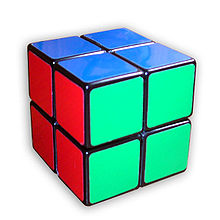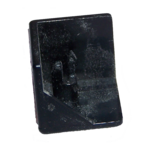Pocket Cube
The Pocket Cube , also known as the Mini Cube, is the 2 × 2 × 2 variant of Ernő Rubik's Rubik's Cube . Each of the six faces consists of four squares , each of which has the same color. It consists of eight parts, each of which has three colors and corresponds to the corner stones of the normal Rubik's Cube. But it has no edge or middle parts. As with the larger variant , the aim of the game of patience is to bring the cube from a disordered position to its orderly basic state by turning it through 90 ° around the three central axes.
history
The Pocket Cube was founded in 1980 by Rubik to patent registered. But there are also patents for other versions of the puzzle, some of which have a completely different shape, such as the head of a Mickey Mouse . Also worth mentioning is the pyramorphix , which has the shape of a tetrahedron , but uses the same rotating mechanism as the pocket cube and therefore changes its shape when you twist the side surfaces. A star-shaped version is also based on the principle.
Maciej Czapiewski holds the current world record in speed cubing with the pocket cube with a time of 0.49 seconds.
Combinations and difficulty level
For beginners it is confusing that there are no fixed parts. You have to combine the correct position of the stones to each other using the corner stones. Although there are not very many positions, the Pocket Cube can hardly be completely solved intuitively. The second layer requires one or more moves that must also appear in the normal Rubik's Cube, the moves that sort the corners and orient them correctly.
Each of the eight stones can take any place in the cube and has three orientations because each has three different colors. Since the pocket cube has no fixed parts that never change their position in relation to one another, it also has no orientation in space: A corner cube can be regarded as correct, then seven positions remain for the other parts, which can be rotated in three different ways. This leads to a theoretical upper limit of 7! 3 7 = 11,022,480 different positions. Due to the mechanism, only a third of this can be assumed, resulting in a number of 7! 3 6 = 3,674,160 leads.
In fact, every corner solution of the normal cube is a solution for the pocket cube. Due to the small number of positions, it can be calculated algorithmically, even using brute force . It turned out that a maximum of eleven movements (90 and 180 ° rotations) are always required to release the pocket cube. If the 180 ° turns are counted as 2 turns, the maximum number of movements required is 14.
The table shows how many positions require at least a certain number of quarter turns to loosen, as well as the number of positions in which each quarter turn reduces the number of quarter turns required to solve by one ("dead ends"):
|
Minimum number of quarter turns required to solve |
Number of positions | of which "dead ends" |
|---|---|---|
| 0 | 1 | 0 |
| 1 | 6th | 0 |
| 2 | 27 | 0 |
| 3 | 120 | 0 |
| 4th | 534 | 0 |
| 5 | 2256 | 0 |
| 6th | 8969 | 0 |
| 7th | 33058 | 16 |
| 8th | 114149 | 53 |
| 9 | 360508 | 260 |
| 10 | 930588 | 1460 |
| 11 | 1350852 | 34088 |
| 12 | 782536 | 402260 |
| 13 | 90280 | 88636 |
| 14th | 276 | 276 |
One of the dead ends, which requires 14 quarter turns, forms a symmetrical pattern that can be called "6 flags": U F2 U F2 U2 R2 U R2 U.
mechanics
Pocket Cube from Eastsheen
The mechanism of the Pocket Cube by Eastsheen differs largely from the mechanism of a normal 3 × 3 × 3 Rubik's Cube. Each level of the cube consists of 3 "layers". The bottom layer is the leftmost black, approximately hemispherical piece of plastic in the photo below. It is firmly connected to the top layer, a small, circular, black plastic disc - on the far right, directly under the green area. There is another black plastic piece between them. It can be rotated between these two layers, so that the stones on the right-hand side, here the ones with the green surface, are attached to it. All of these three layers can be rotated completely with another rotation thanks to the hollows in the corner stones. The covers of the corner stones, which can be seen from the outside, are simply placed on the brackets provided.
Pocket Cube from Rubik's
The rotating mechanism of the Pocket Cube from Rubik is similar to that of the 3 × 3 × 3 Rubik's Cube.
Web links
- Jaap's Pocket Cube Site (English page with solution, links and pictures)
Individual evidence
- ↑ Patent US4378117 : Spatial Logical Toy. (Priority registration on October 2, 1980 in Hungary).
- ↑ Jaap Scherphuis: Pyramorphix
- ↑ Ranking of the record times in solving the Pocket Cube website of the World Cube Association
- ↑ http://cubezzz.dyndns.org/drupal/text/fullcube.txt



